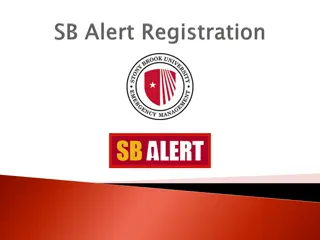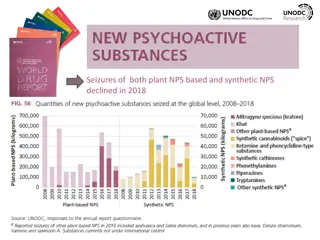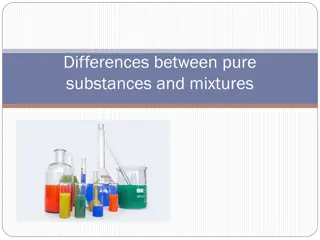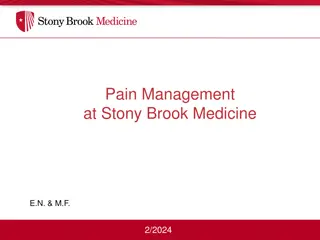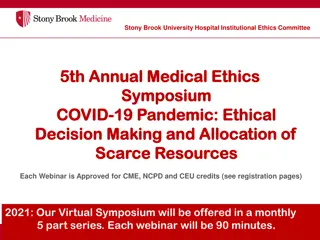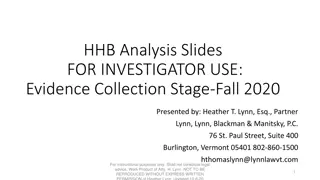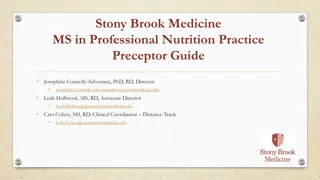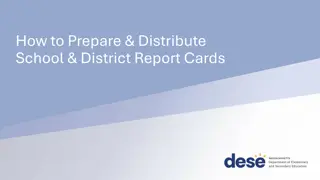
Understanding Controlled Substances and the CSA Regulations
Explore the regulations surrounding controlled substances under the Controlled Substances Act (CSA) of the United States, covering their classification, legal requirements, and regulatory considerations. Learn about the placement of controlled substances in different schedules, licensing requirements for Principal Investigators, and methods to identify controlled substances. Stay informed about the evolving landscape of controlled substances and their implications in research and compliance.
Download Presentation

Please find below an Image/Link to download the presentation.
The content on the website is provided AS IS for your information and personal use only. It may not be sold, licensed, or shared on other websites without obtaining consent from the author. If you encounter any issues during the download, it is possible that the publisher has removed the file from their server.
You are allowed to download the files provided on this website for personal or commercial use, subject to the condition that they are used lawfully. All files are the property of their respective owners.
The content on the website is provided AS IS for your information and personal use only. It may not be sold, licensed, or shared on other websites without obtaining consent from the author.
E N D
Presentation Transcript
Office of Research Compliance The Office of Research Compliance has adapted the Vermont University controlled substances training with permission (2024)
Controlled Substances Act (CSA) Title II of the Comprehensive Drug Abuse Prevention and Control Act of 1970 is the United States drug policy by which the manufacture, possession, use and distribution of certain narcotics, stimulants, depressants, hallucinogens, anabolic steroids and other chemicals is regulated 2
Controlled Substances A controlled substance is a drug or chemical whose manufacture, possession, storage, use or disposal is regulated by the Drug Enforcement Administration (DEA) Included are all chemical substances in Schedules I-V of the Controlled Substances Act and any listed in the state laws of New York 3
Controlled Substances Placement of a controlled substance into one of the five Schedules is based on the following: - Medical use - Potential for abuse - Psychological or physiological dependence Since 1970, many substances have been added, removed, or transferred from one schedule to another. An updated list of the schedules is published annually in Title 21 Code of Federal Regulations (CFR) 1308.11-1308.15 4
Controlled Substances Before ordering controlled substances, each Principal Investigator must have a license/registration from: - Bureau of Narcotic Enforcement (BNE) - Drug Enforcement Administration (DEA) NOTE: The Drug Enforcement Administration is a law enforcement agency and can prosecute violators of the Controlled Substances Act 5
Controlled Substances You can check whether the substance is a controlled substance by looking on the box. Often there is a capital C and roman numerals on the original packaging. 6
Schedule I Controlled Substances No currently accepted medical use in the United States, a lack of accepted safety for use under medical supervision, and a high potential for abuse Examples include: Heroin Lysergic acid diethylamide (LSD) Marijuana (cannabis) Peyote Methaqualone 3,4-methylenedioxymethamphetamine ( Ecstasy ) 7
Schedule II/IIN Controlled Substances High potential for abuse which may lead to severe psychological or physical dependence. Examples include: Methadone Oxycodone Fentanyl Morphine Opium Codeine Cocaine Methamphetamine 8
Schedule III/IIIN Controlled Substances Potential for abuse is less then substances in Schedules I or II and abuse may lead to moderate or low physical or high psychological dependence. Examples include: Benzphetamine Phendimetrazine Ketamine Anabolic steroids 9
Schedule IV Controlled Substances Low potential for abuse relative to substances in Schedule III. Examples include: Alprazolam Carisoprodol Clonazepam Clorazepate Diazepam Lorazepam Midazolam Temazepam 10
Schedule V Controlled Substances Low potential for abuse relative to substances in Schedule IV and contain preparations containing limited quantities of certain narcotics. Examples include: Ezogavine Lomotil Motofen Lyrica Parepectolin Cough preparatons (Robitussin AC, Phenerganwith Codeine) 11
Investigator Responsibilities Each person who orders, handles, or stores controlled substances must be registered with the DEA and a license with the BNE to perform these functions: - Designate Authorized Users (an authorized user is a member of the research team who has completed training and is approved to handle controlled substances in the laboratory) - Ensure that controlled substances are stored in a manner that prevents their theft or misuse - Ensure the appropriate disposal of controlled substances 12
Investigator Responsibilities The DEA registrant is the person who is responsible for keeping controlled substance records. - Not the office manager - Not the lab assistant - Not the vendor - Nor the employer/university 13
Security Requirements - Ensure that controlled substances are stored in a manner that prevents their theft or misuse - Store controlled substances at the location specified in the registration, in a double-locked, substantially constructed cabinet that is fixed permanently in place - Ensure that only authorized users have access to controlled substances - Keep the storage unit locked when not in use - Do not use bicycle locks, clasp locks or any other locking device that can be cut off the cabinet used for storing controlled substances store controlled substances at the location specified in the registration, in a double-locked, substantially constructed cabinet that is fixed in place 14
Storage Requirements When you receive shipment of controlled substances: - You must sign for the package, open it immediately and secure the contents in the lock box or safe. - Note the date received on the packing slip and keep this record - Add the controlled substance received to your usage log for that drug NOTE: Controlled substances cannot be shipped to Central Receiving store controlled substances at the location specified in the registration, in a double-locked, substantially constructed cabinet that is fixed in place 15
Theft or Loss All employees or students are required to report diversion of controlled substances. Any suspected theft, loss, or diversion must be immediately reported to: - Division of Laboratory Animal Resources at 631- 444-2194 - AREA DEA Field Division Office must be notified in writing within one business day of discovery of loss or theft. - Complete and submit DEA Form 106 Report of Theft or Loss of Controlled Substances - Registrants are encouraged to immediately report theft and loss to local law enforcement and the state regulatory agency. store controlled substances at the location specified in the registration, in a double-locked, substantially constructed cabinet that is fixed in place 16
Spills - Breakage, spills or other witnessed controlled substance loss do not need to be reported as lost - This type of loss must be documented by the registrant and witness on the inventory record - Controlled substances that can be recovered after a spill, but cannot be used because of contamination (such as tablets), must be disposed of in accordance with disposal procedures store controlled substances at the location specified in the registration, in a double-locked, substantially constructed cabinet that is fixed in place 17
Record Keeping - Records for schedule I and schedule II substances should be kept separately from records for schedule III-V - Inventory for all locations must be updated every 2 years. The inventory will consist of: - Hands-on counting of inventory - Complete within a single business day - Complete by at lease two authorized personnel - Inventory must be maintained at the Registered Location (The inventory can be written, typewritten, or printed.) - Label the inventory Biennial Inventory (If nothing to record indicate 0 ) 18
Record Keeping cont. - Usage logs must be maintained for controlled substances at each physical location where they are stored - The use of controlled drugs are always documented by the date, purpose, amount used, balance remaining and the initials of the person administering the drug. Example: DRUG: Buprenorphine Concentration: 0.3 mg/ml Date: 1/1/2024 7/1/2024 Purpose: Add Mouse Surgery Used: 1.00 ml 0.01 ml Balance: 1.00 ml 0.99 ml Initials: JD RB 19
Disposal Out-of-date, damaged, or otherwise unusable or unwanted controlled substances can be disposed of in the following way: - Administering the drug to an animal carcass and documenting the administration on the usage log NOTE: a second authorized user must be present to witness and sign the usage log - Reverse Distribution Contact the ORC for guidance (requires DEA Form 41) NOTE: No drugs are to be thrown out or dumped into the sink. store controlled substances at the location specified in the registration, in a double-locked, substantially constructed cabinet that is fixed in place 20
Inspections The DEA makes periodic unannounced inspections of registered controlled substance storage locations. Additionally, reporting a loss or theft may result in a DEA inspection or visit. The DEA is a law enforcement agency, with the ability to assess civil and criminal penalties During the IACUC semi-annual inspections, representatives will review storage areas, use/logs, and security controls. store controlled substances at the location specified in the registration, in a double-locked, substantially constructed cabinet that is fixed in place 21
Non-Compliance - The Office of Research Compliance will respond to observations of non-compliance, and recommend corrective actions to appropriate personnel including the Department Chair, Dean, Vice President for Research, SBU police, and/or U.S. DEA - Consequences of non-compliance may include loss of authorization to use controlled substances at SBU, revocation of the DEA registration, termination of employment, or referral to law enforcement agencies. store controlled substances at the location specified in the registration, in a double-locked, substantially constructed cabinet that is fixed in place 22


